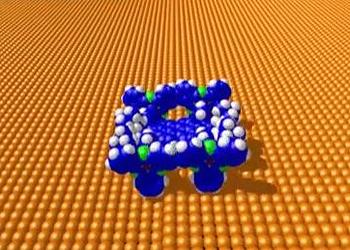
TOULOUSE, France, March 23, 2017 (ENS) – NanoCars will compete for the first time ever during an international molecule-car race to be held on April 28-29 in Toulouse, southwestern France.
The vehicles, which consist of just a few hundred atoms, will be powered by minute electrical pulses during the 36 hour-long race.
They must navigate a racetrack 100 nanometers long made of gold atoms placed inside a one of a kind scanning tunneling microscope.

Racing at the crossroads of physics and motorsports, these NanoCars, or molecule-cars, are a million times smaller than a millimeter yet they can have real wheels on an actual chassis.
Nothing is visible to the naked eye, but the unique microscope in Toulouse will make it possible to follow the race.
A scientific and technological challenge and an international human adventure, the race is a one-time event. It will be broadcast live on the YouTube Nanocar Race channel, as well as at the Quai des Savoirs museum of science and technology in Toulouse.
The race is organized by the CNRS, the French National Center for Scientific Research, which is the largest governmental research organization in France and the largest fundamental science agency in Europe.
The organizers say, “A genuine atom technology is dawning.”
The infinitesimally small cars will square off beneath the four tips of a unique microscope located at the CNRS’s Centre for Materials development and structural studies, or CEMES, in Toulouse.
More than just a competition, the Nanocar Race is an international scientific experiment that will be conducted in real time, with the aim of testing the performance of molecule-machines and the scientific instruments used to control them.
The future use of such molecular machinery, activated individually or in synchronized fashion, could be in the manufacture of common machines: atom-by-atom construction of electronic circuits, atom-by-atom deconstruction of industrial waste, or the capture of energy.
So the Nanocar Race is a unique opportunity for researchers to implement cutting-edge techniques for the simultaneous observation and independent maneuvering of such nano-machines.
The experiment began in 2013 as part of an overview of nano-machine research for a scientific journal, when the idea for a car race took shape in the minds of CNRS senior researcher Christian Joachim, now the director of the race, and Gwénaël Rapenne, a professor of chemistry at Université Toulouse III – Paul Sabatier.
Three years later, the nanocars are operational and ready to race on the circuit’s gold surface.
There were numerous challenges in organizing this race, from selecting the racecourse, which must accommodate all types of molecule-cars, to adapting the scanning tunneling microscope.
The participating teams also had to overcome a series of difficult tasks, such as depositing and visualizing the molecules beneath the microscope. They had to meet numerous criteria regarding the molecules’ structure and form of propulsion in order to participate in this race.
Of the nine teams that applied before the end of May 2016, six were selected, and four will take their places at the 4-tip microscope’s starting line on April 28 for the 36-hour race.
The challenges facing researchers in the race will be so many steps forward in novel fields in chemistry and physics.
In the process, each team will build up new skills, data, and know-how that will one day contribute to the development of surface chemistry, which enables chemical synthesis directly on a particular surface.
They will contribute to the new science of surfaces known as membrane science, which makes it possible to deposit a molecule-machine on the surface of a cell, or to control the movement of a single molecule in a liquid.
The CEMES-CNRS microscope is the only one in the world that allows four different experimenters to work on the same surface.
The development of such multi-tip microscopes will enable the synchronization of a great number of molecule-machines in order to increase capacity, for instance for storing energy or capturing it from a hot metallic surface.
Copyright Environment News Service (ENS) 2017. All rights reserved.
© 2017, Environment News Service. All rights reserved. Content may be quoted only with proper attribution and a direct link to the original article. Full reproduction is prohibited.
